-
Posts
1,065 -
Joined
-
Last visited
-
Days Won
1
Content Type
Profiles
Forums
Blogs
Gallery
Events
Store
Posts posted by Graham Stewart
-
-
Now that is interesting as I've never seen anything like it before, although it looks as though there is one more letter than just the 'R's reversed and intertwined. I have a "Recruiters Pamphlet" for the late 1890's and there's no mention of a "specific badge" for them in there although I knew of the ribbons being worn. Would you object if I told David Langley about this, as I'm unaware of one in his book??
0 -
I think they are reversed & intertwined "R"s, worn by Recruiters.
I have a colour card somewhere of a Recruiter in Blues wearing the badge - I was wondering if they were worn by retired personnel in lieu of the crossed Union flags over chevrons?
There's always confusion over the recruiters badge as you and I know it(crossed union flags over chevrons) as prior to 1915 it was worn by "all" Colour Sergeants within the infantry in full dress. In SD dress the Clr Sgt wore a large crown over three chevrons, again not to be confused with the post 1915 rank of CQMS.
I didn't know of a specific badge for recruiters and wonder if you could get a good blow up of it.
0 -
Leigh - out of curiosity what are Turners 'cuff' rank badges in post 63 - they certainly look a little unusual and don't appear to be either RSM or RQMS, or is it just my eyes these days??
0 -
I'm afraid the British Army is governed by 'patterns', which in the case of rank are strictly adhered to and as such something like this unlikely to be ever be worn, especially by a WOII. As for a form of "livery" badge, again I'm not convinced, especially with a khaki background. I still think you're looking at a European Army post 1900 and it may even be a collar badge or shoulder strap badge rather than for wear on the arm as a source of rank.
0 -
Post 23 isn't British, but certainly looks European, with it's distinctive crown. The shape reminds of more Eastern Europe than west, perhaps Imperial Russia or around that area. Service Dress(SD) for the British Army didn't appear until the beginning of the last century for wear at home in the UK, although Khaki Drill(KD) had been worn for a number of years prior to that while overseas. Prior to that scarlet dominated the field both at home and abroad.
0 -
Have had another trawl through and found his Grouping was 9/27 and this can be seen on his A.F. B.103 "Casualty Form Active Service" form. I haven't got my notes with me, which would have told me his trade band.
Under the Derby Scheme enlistment was voluntary, but your call-up was delayed depending on family circumstances. However the Group's of the Derby Scheme weren't called forward until January 1916, the initial batches going to the Territorial infantry.
The following May/June 1916 the Miltary Service Act comes into being, which we more know as Conscription. This system used the Derby Scheme's earlier organisational set-up to call forward Conscripts.
Military Tribunals were also prevelant at the same time in which those who were 'conscripted', could appeal that their work was of more use to the war effort. This didn't effect the Derby Scheme lads as they had already indicated as Volunteers that they would serve no matter what, but their social status obviously decreed which Group they were placed in and when they would be called up. For instance if I remember correctly 19year old's, who were single, were placed in Group 1 and so on.
Later Army Council Instructions would relay to administrators which Conscripted Groups would be called forward and which sections of the Army they would serve in. All-in-all both schemes worked very well in supplying men for the front, as it was the fairest way in which to see the men distributed.
0 -
They are quite difficult to read, but I did find another unit that he was posted to. His original unit appears to 447th Siege Battery, but is posred to 149th Siege Batttery on 7/9/1918, but returns to 447th and is then posted to 223rd Siege Battery on 21/3/1919.
Now here are some interesting bits for us Geeks;- he "Attests" on the 8/12/1915. Which would be in compliance with the National Registration Act of 1915, but I'm not sure if it's with the Group System(Derby Scheme), which commenced early in 1915, a good year before the Miltary Services Act(Conscription) came into force.
The following day 9/12/1915 he is placed on the "Army Reserve" and sent home, this may be because it appears that he lives with his mother who may be a widow.
He isn't "Mobilised" until 5/5/1917, so he is infact a late entry into the war. Again though I can't see anything which would imply whether he was called up as a Derby Scheme lad(Volunteer) or under the M.S.A.(Conscript).
0 -
Can only identify two units he served with from the documents and thats 447th Siege Battery and 223rd Siege Battery, R.G.A.
0 -
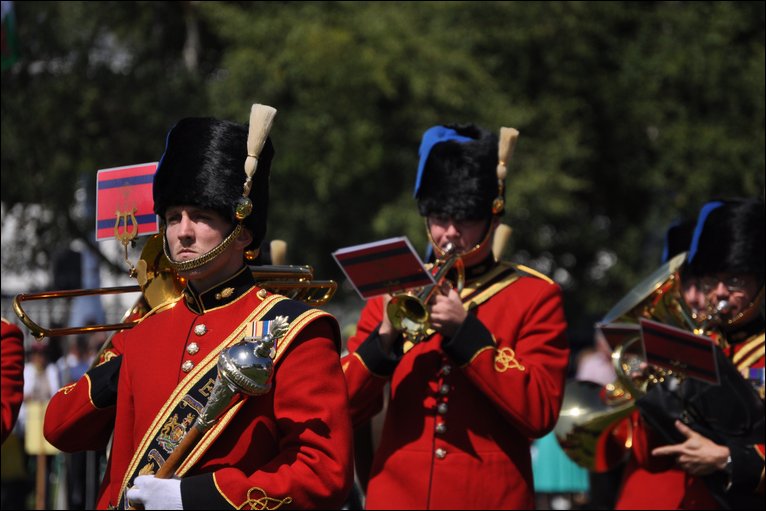
Here you go Mev - the RE Band at Taunton Flower Show.
0 -
There was also "Rifle Grenadier", the title of which caused some problems with the Brigade of Guards. I've only ever seen one photo of a likely candidate and on his lower left arm was your crossed rifles in brass and in between the barrels of the rifles a small brass grenade, as worn by Fusiliers on S/T's and RE's. Both ACI's and AO's refer to such an appointment.
"Bombers" if not obtaining the cloth version are known and seen to be wearing the brass grenade mentioned in the last paragraph, with the flames painted red.
0 -
Just thought you'd like to know David Langley is currently writing another book on rank & profficiency badges and I've supplied some photo's from my NF photo collection, which may be produced as illustrations. He's been through copies of AO's, WOI's and ACI's as well as various other forms of regulations to update the lastest work.
0 -
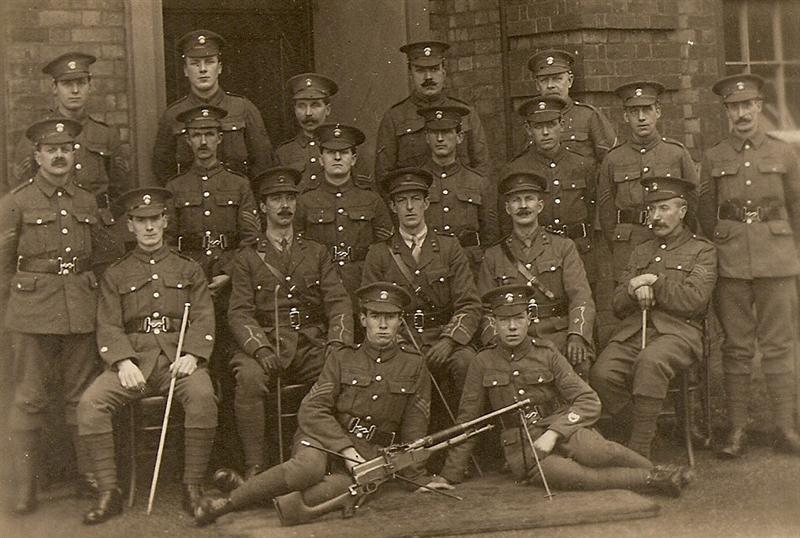
The weapon in question with 3rd V.B.,Northumberland Fusiliers post July 1918. A closer examination of the gunners badge will show 'HG' in a wreath.
0 -
"It's probable that they were being worn by TA Hotchkiss Gunners, the Hotchkiss was phased out of the Regular Army by 1940, the Regulars had adopted LG in wreath in 1921, it's likely that the TF adopted the "LG" without wreath as it now stood for Light (Machine) Gunner."
Would I be correct in saying that the primary heavy weapon's of the TF/TA infantry would be either a Maxim, Vickers or Lewis Gun rather than the Hotchkiss? The only photo I have of infantry with the Hotchkiss is members of the Volunteer Force in 1918 and there again I believe the qualification badge was "HG" in the wreath? As far as I'm aware the Hotchkiss was primarily used by the cavalry and yeomanry due to the weight of the Maxim and Vickers, which in infantry battalions had to be carried on specially adopted carts drawn by horse.
0 -
Have to concede it is an 'other ranks' shako, as the photographs on the Light Infantry site although of poor quality, when blown up show an additional item being worn above the cap badge which will be the boss badge as seen on your item. I was honestly unaware that the HLI wore a boss above the HLI badge on the shako and have never ever seen one for sale - has anyone else?
Apologies to you Merv for building your hopes up and thanks to Coldstream2 for putting us right. At least I've learned something today. Think I'll stick to Fusiliers stuff in future :D
0 -
Wonder if anyone has a photo of O/Rs wearing their shako, as it would be intersting to see if a cord boss was worn by them above the cap badge. I've never come across a cord boss described as such for the HLI O/R's. The WD lable may be there because it may be or was a "sealed pattern". All accoutrements originated from 'sealed pattern' items approved by the WO and Clothing Dept.
As Coldstream2 has mentioned there appears to have been a pattern for senior ranks, which may differ from that of the O/R's.
0 -
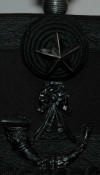
Their officers badge and cord boss.
0 -
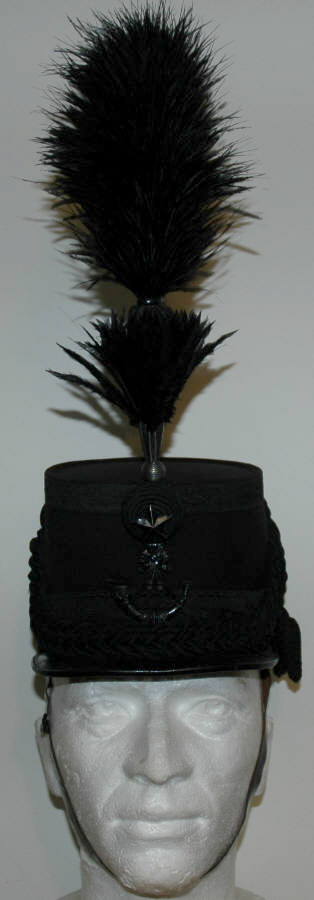
The same type of head-dress as worn by the Cameronians.
0 -
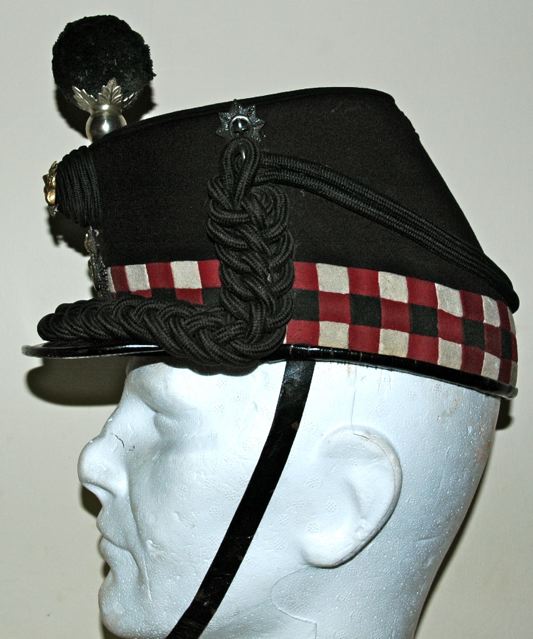
Side view of the same. Sorry to have built your hopes up Mervyn, but you can see the difference in quality.
0 -

Badge, ball tuft and holder and the cord boss.
0 -
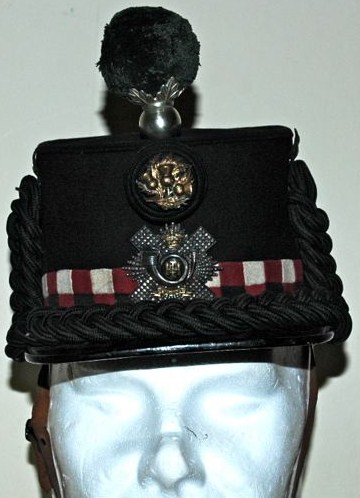
Seems as though I might have been too keen to declare it as an officers pattern shako, as this is what one looks like.
0 -
Double checked regarding the Cameronians and they did wear the Home Service helmet and there's a Home Service helmet plate belonging to the Scottish Rifles for sale on a certain auction site.
0 -
I've looked at some prints of the HLI and still thinks it's an officers due to the fact a cord boss is being worn, along with the cord braiding, whereas the other-ranks would be plain apart from the cap badge & dicing. Only WOI's would wear a pattern similar to officer as befits their rank. It appears their other ranks may have continued to wear this form of headr-dress post 1881, although I'm certain I've seen photographs of both the HLI & Cameronians wearing the Home Service helmet, but I could be wrong.
0 -
I've none of my regimental histories here with me, but I seem to recall that the 5th Fusiliers(later Northumberland Fusiliers) had served in South Africa during an earlier period, but can't recall dates or places. The 4th Bn,N.F. in which Morgan served was one of the new regular NF Battalions raised during the later South African War(1899-1902), although I'm certain the battalion never served there.
0 -
If I remember correctly only the officers of the HLI continued to wear this form of head-dress post 1881. The remainder of the infantry apart from Highland Regiments and Fusiliers went onto adopt the Home Service pattern helmet, this I believe included the O/R's of the HLI.
0




Regimental numbers...
in Great Britain: Research, Documentation & History
Posted
Apart from the T.F. numbering you've just mentioned introduced in 1917, I don't think anything else about regimental numbering appears in the GMIC. However RWF numbering is covered quite extensively in this booklet;-
"Regimental and Army Numbers of the British Line Infantry Soldier from AD.1800 to 2008", written by David Langley and myself.
I believe it's now going into it's fourth reprint, but don't ask me where a copy can be obtained from as David handled all of the sales, since I now live and work in Saudi.